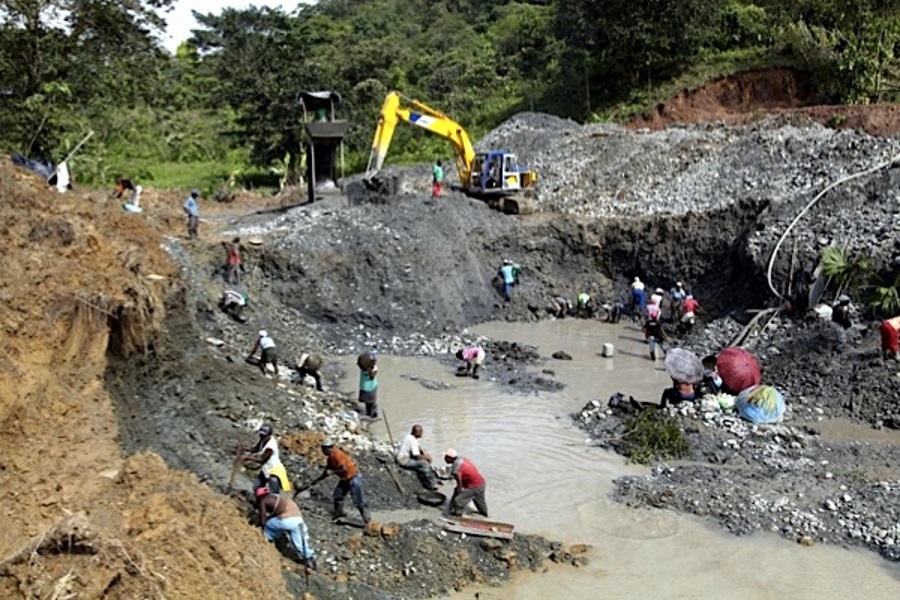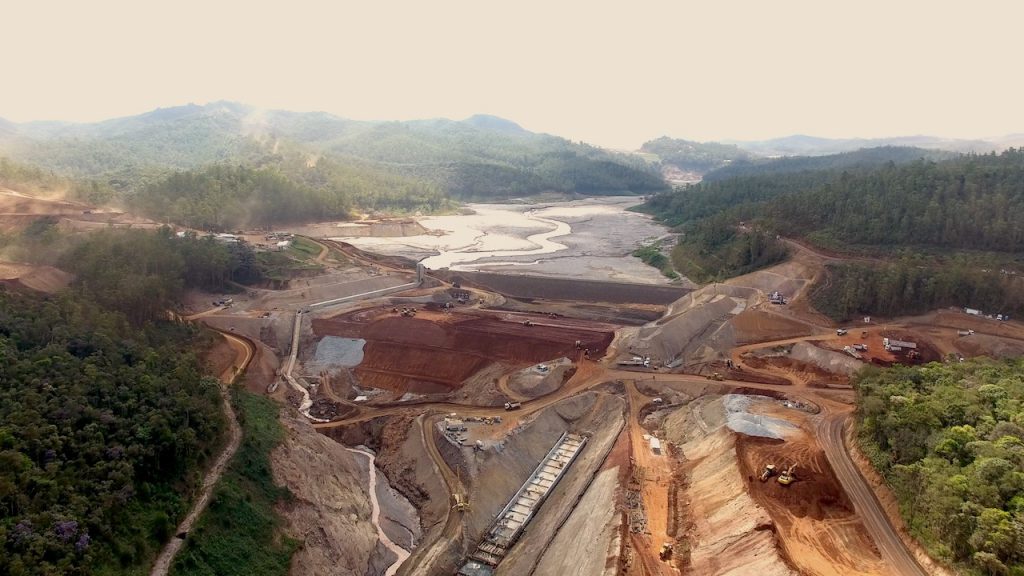Colombia: Golden future, difficult reality

I came to Colombia primarily to answer one question: this country may offer immense mineral potential but is it a good place to spend some investment dollars?
It’s a tricky question.
I spent the first two days of my trip at the Colombia Gold Symposium. It was the inaugural event, put together by Paul Harris of the Colombia Gold Report (a great, free, South America-focused gold newsletter). First off, huge thanks to Paul for the event. It was very well organized and attended, with over 200 local and international explorers, miners, investors, lawyers, and the like, all sharing their interest or experience in Colombia.
I learned a lot. I came here hoping to get all jazzed about Colombia as a new exploration hotspot, buoyed by the peace process and Red Eagle Mining’s success building a mine at Santa Rosa.
Unfortunately, that is not exactly how I feel.
Colombia has a complicated relationship with mining. The country produces on the order of 60 tonnes of gold annually, but 85% of it comes from illegal operations. Those operations have two very important downsides:
- Environmental destruction. The easiest mining was from alluvial gravels, in old or current river beds, and processing those gravels destroyed waterways. Now much of the work has progress to open pit operations, which are again scarring the landscape. Most important, though, are the cyanide and mercury from processing. Both are used abundantly and both are literally washed into the soils and rivers. The population knows it and as a result hates mining.
- Guerrilla control. The reason the government does not stop the illegal operations or at least force them to clean up is that many are controlled by guerrillas. The FARC and ELN and such groups need income; they realized years ago that mining serves that need well. They either operate mines or coerce miners to ‘share’ proceeds in exchange for ‘protection’. Especially since the government entered peace talks with the FARC, the very idea of fighting against illegal mining has been off the table so they operate without restraint.
Fighters do not control all of the illegal mining operations. The miners around Cordoba’s project – within its project, in fact – are independent. They still use cyanide but the lack of security risk means Cordoba was able to become their partner. More on that in my Cordoba site visit writeup.
Illegal mining has pushed Colombians to hate the very idea of mining – with no differentiation between legal and illegal operations. That is largely because there are so few legal mines, relative to the non. In the north (again, near Cordoba) there are some nickel and coal mines, so folks in that area understand the difference, but on average Colombians don’t distinguish between legal and illegal and thus assume legal operations are just as environmentally destructive, and perhaps as socially challenging, as illegal operations controlled by fighters.
Now put that all in the context of a populist government focused on negotiating peace with the FARC. To simplify a very complicated situation, this has a few key results.
- The government is 100% focused on peace. That means other areas in need of attention, like the systems for granting concessions or mine permits, are getting zero attention.
- The peace process is contentious. To maintain support while pushing through a deal that many Colombians detest (for the amnesty it offers combatants, primarily), the government actively and passively maintains popular systems and positions. One is the dysfunctional system for granting exploration concessions and mine permits. The systems are duplicitous, with parallel bodies empowered to make decisions that do not communicate with each other, but that creates ample opportunity for blame: when concessions take two years or the rules change while a company is exploring or permitting, the bodies point fingers at each other and sidestep blame.
- More generally, there is no effort to generate widespread government support for mining. For example, the ministry of the environment does not communicate with the ministry of mines when changing park borders. That is how several explorers and developers got caught up in the Paramo net, where the definition of a protected High Alpine area was changed and rendered several projects invalid. Such things would not happen were there government-wide interest in mining, but there is not and cannot be because of the broad social opposition to mining.
At the end of the day, it means explorers in Colombia (most parts) face three key challenges:
- Difficulty in being confident about property ownership and abilities. Will you actually be able to build a mine on your asset? Very hard to know.
- The threat of changing environmental rules after the fact.
- Long delays in getting permits and concessions. Like, years long.
Some areas are better than others. The Cordoba area, as I mentioned, seems significantly more functional than other parts of the country. By contrast some areas are complete No Go zones, whether because of intense popular opposition to mining or because of security risks.
The security question could be changing, but time will tell. The idea is that a peace deal with the FARC will open up highly prospective areas that have been absolutely off limits for decades because of guerrilla control. That includes, for example, the south end of the Mid Cacau belt in Colombia. The central and north parts of the belt in the country are the prime areas of exploration and discovery. And the belt farther south, across the border in Ecuador, hosts several significant discoveries. As such geologists drool over the idea of the south end of the belt in Colombia, but guerrilla control meant exploration was not an option.
If the peace deal goes through, this area could open up. Whether and when this actually happens is another question. The peace deal is not yet signed. The public said no. The government went back to the negotiating table and managed to amend major parts of the agreement. Now the idea is to put it to Congress, rather than another referendum.
Odds it will get signed are good. The realities of implementing it are another thing. This deal requires Colombians to reincorporate the very people, the guerrilla fighters, who terrorized and killed them. Many of those fighters have never known any other life: they have no education or skills other than fighting. And the deal is only with the FARC – there is also the ELN, with whom peace talks remain in limbo until they release a few key hostages, as well as a handful of other guerrilla groups of similar inclinations. The paramilitaries – the self-organized militias that fought the guerrillas – signed a peace deal ten years ago and disbanded…though in their pace armed bands grew up and still exist.
And amidst all that, Colombia still grows and exports lots of cocaine.
It is a complex situation. I think peace is possible – inevitable, actually – because after 50 years of war, of being terrorized in their own cities, of having friends and relatives killed or kidnapped, the people of Colombia will accept no other outcome.
Medellin is a living example: 15 years ago Medellin was the most dangerous city in the world and today, with Escobar dead and political and social will having shifted determinedly to retaking control of their home, Medellin is safe (generally) and prosperous. Places that used to be incredibly dangerous, laced with drugs and terror, have been actively transformed into safe plazas, libraries, and parks where people now relax. The change is incredible.
The country as a whole will experience that too…but it will take time. A lot of time.
While that happens, operating in Colombia will remain difficult for explorers and miners. Permits will remain elusive. Concessions will still take years to obtain. Certainty of tenure will remain tenuous.
Red Eagle’s success building the in-commissioning San Ramon mine is, however, proof that Colombia can work. And when it does, the result is a mine tapping into ore carrying an average of 5.2 g/t gold to generate an expected 53% post-tax internal rate of return. I will have more to say about Red Eagle in another letter, but for now suffice it to say that Colombian geology lives up to the hype, providing the grade and continuity that underlie successful mines.
How did Red Eagle do it? Conscientiously. They fit the entire process plant and tailing facility onto a footprint of just 16 hectares and hid it – literally – behind a ridge so as to minimize disturbance to locals. Their community relations program is deep, continuous, and responsive. They knew Colombians are not likely ready to permit an open pit mine, so part of the reason they honed in on San Ramon as their project five years ago was because it was clearly an underground operation. They installed a dry stack tailings filter press, so the tailing facility is essentially a block of cement-sand rather than a pond. All of the water used in the mine and plant stays in a closed circuit and thus is not discharged.
It is conscientious mining and it works.
Cordoba is still in the exploration stage, but its approach is similar and is working. Again, I will have more to say in my complete site visit writeup, but for now I will say that the most important thing I took away from my day with Cordoba were the smiles and waves from the locals. Cordoba’s property surrounds a mining village, where hand-hewn adits and a pseudo tailings pit are in the center of town, where ore is leaching in cyanide on tables everywhere, and where homemade balls mills rattle constantly.
The people are poor. I have been in similar situations before, driving through a poor town on the way to visit an exploration project, and many times the stares are icy, distrustful, dark. At Alacran it was the opposite: the people smiled and waved. They clearly support Cordoba fully – and that, provided it persists, will be the difference maker if Cordoba defines an economic resource and wants to permit a mine. So while I learned lots about the geology and the exploration plans and the size of the operation and the like, the most important takeaway was that Cordoba has social license to operate.
Colombia will be a major gold producer. It’s not a question of if; it is only a question of when. The mineral potential here is incredible. Majors are looking around and angling to establish some kind of a foot in the door. The challenges of exploring are real. They can be managed, though for now only in parts of the country where social support is possible, and that is not everywhere. Peace will open up parts of the country that have been impossible to date, but peace will take time.
Peace is also inevitable. Colombians are ready. Fifty years of war will do that. The details of that process and the challenges of reintegrating guerrilla warriors into society are sitting in front of the country right now like huge stumbling blocks, just waiting to trip things up. No peace process is smooth. Colombians have learnt to be patient.
Investors interested in Colombia have to also be patient. Past experience has made society here very distrustful of mining. Some areas are more amenable, with the right approach. Other areas remain impossible, for now. The same is true with regards to peace opening up new areas for exploration – some areas will open up as peace happens but others will remain close, because after all Colombia does sit produce a lot of cocaine.
It’s a complicated and beautiful place, with oodles of gold and incredibly friendly people who are actively trying to forget their bloody past. It is not an easy place to operate (few places today are) but if you understand where you are working and what is needed, success is possible.
{{ commodity.name }}
{{ post.title }}
{{ post.date }}

Comments